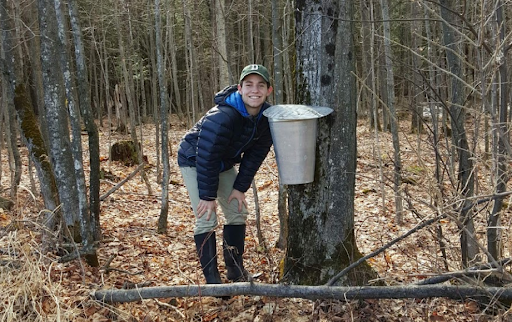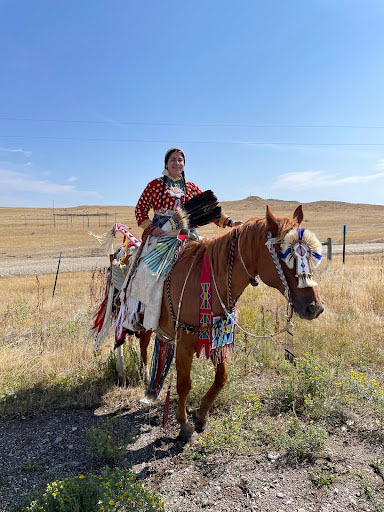
JoRee LaFrance and Alexander Cotnoir, making the Indigenous Correspondents Program announcement at the 2022 Planet Forward Summit in April, on stage with Frank Sesno. (PlanetForward.org)

JoRee LaFrance and Alexander Cotnoir, making the Indigenous Correspondents Program announcement at the 2022 Planet Forward Summit in April, on stage with Frank Sesno. (PlanetForward.org)
The first cohort of Indigenous Correspondents, working with Native mentors and communication experts in environmental journalism, storytelling, and multimedia, are beginning their 10-month journey in learning about communication through hands-on workshops and working with a Planet Forward-hosted Indigenous editorial mentor to publish on the platform. The 12 upper-division Indigenous undergraduates and graduate students in the Ilíiaitchik: Indigenous Correspondents Program, founded by graduate students JoRee LaFrance, of the University of Arizona, and Alexander Cotnoir, recently graduated from George Washington University, represent nine different tribes from across the United States.
Through social gatherings and workshops led by Indigenous mentors, the program seeks to build community and communication skills to empower the next generation of Indigenous storytellers. Planet Forward’s Lisa Palmer recently spoke with Cotnoir and LaFrance about what inspired them to create the program.
Palmer: Can you tell us about your background and what made you want to focus on creating a space for Indigenous environmental storytellers?
Cotnoir: Kwaï! Ndeliwizi Alexander. Nojiawi Mamlawbagok. My name is Alexander, and I grew up along the shores of Lake Memphremagog. I am a citizen of the Nulhegan Band of the Coosuk-Abenaki Tribe. My family comes from Trois-Rivières along the Saint François River, as well as Coaticook, Quebec and Vermont’s Northeast Kingdom. I’m passionate about food systems and understanding how climate change impacts northern forests, including the species and communities that depend upon them, given my experiences growing up in a family and community that makes maple syrup from the woods behind our home each spring, carrying on our community’s long tradition of making local food. I’ve witnessed firsthand how many of our local practices — from ice fishing, snowshoeing, and ash basket making to maple sugaring — are threatened by warmer winters and the associated influx of invasive species brought about by climate change.

LaFrance: Kahay! Baalaashe Iichiinmaatchileesh huuk. Basammalíaxxia biiuuwuutasshiik deelé koon biixúhkaalaxchebaakaatik. Binnéesappeele kookakawook. Iikooshtakáatbaatchaache kookakawook. Hello. My Apsáalooke name is Fortunate with Horses and my English name is JoRee LaFrance. I come from the Greasy Mouth clan and I am a child of the Ties the Bundle clan. I come from the River Crow band. I am from the Mighty Few district at the foothills of the Big Horn Mountains on the Crow Reservation in southeastern Montana.
Cotnoir: My passion for environmental storytelling comes from recognizing that, although Indigenous communities have contributed little to global carbon emissions, we are disproportionately impacted by the loss of species and habitats brought about by global warming. This disproportionate impact is because our spirituality and identities are formed through interactions with local plants, animals, medicines, land, and waters. Thus, anything that threatens the health of local ecosystems threatens our community’s health.

Today, my work in science communication is grounded in the recognition that science is but one among several ways of understanding the world. If we are to fully combat and adapt to climate change, we need policymakers and scientists to value other ways of knowing, including Indigenous knowledge. Indigenous knowledge is powerful because it is imbued with ethics, and it’s time and field-tested. Indigenous knowledge teaches us what to look for — so it can help us better predict and adapt to environmental changes. I seek to honor Indigenous ways of knowing, as well as the knowledge-bearers that have passed down their experiences to the younger generations through the stories I tell.
LaFrance: I am the 7th generation of Chief Déaxitchish/Pretty Eagle, the last principal chief of the Apsáalooke Nation, and one of the first five Apsáalooke delegation members to travel to Washington, D.C., on behalf of our people. I am proud to come from families who are known for our horsemanship, horse parade sets, our original red elk tooth dress, kindness, love, and hard work. My ultimate goal is to return to my homelands and continue my heart’s work. I strive to live in a world where my people can be unapologetically Apsáalooke and am working hard to be a good ancestor.
Palmer: Where did the idea for the Ilíiaitchik: Indigenous Correspondents Program come from? What are you hoping to accomplish with this program?
Cotnoir: We recognized the need for an Indigenous space where students interested in sharing their experiences and communicating environmental issues to the general public can gather, form a community, and strengthen their communication skills by learning directly from Indigenous leaders in the communication field.
LaFrance: Although representation of Indigenous writers, podcasters, filmmakers, and storytellers has grown in recent years, reporting about science and the environment has not always been inclusive nor respectful of Indigenous communities and knowledge systems.
Cotnoir: In the past, reporting on “Native issues” was typically done solely by non-Indigenous reporters, with little to no continued connections to the communities they reported on beyond the interview period. Today, a lot of work remains to make journalism — a process steeped in colonial ideas about who holds the right to tell stories — more accessible and equitable for Native people.
LaFrance: Although Indigenous communities are disproportionately impacted by climate change and global biodiversity loss, only a very small percentage of scientists, professors, and science journalists at U.S. universities and news organizations are Indigenous. Despite modest increases in Indigenous representation among STEM professionals in recent years, recent research from the Institute for Scientific Information shows that between 2010 and 2020, there “was virtually no change in the representation of Black, Hispanic, and Native American researchers among authors of scientific publications” a symptom of structural inequality, including underfunding of BIPOC academics. This lack of resources and representation influences the coverage and perspectives around environmental justice, climate adaptation, and environmental policy issues while perpetuating harmful stereotypes about Native communities.
Now is the time for Indigenous people to write their own stories about their communities. We have the power to tell our own stories, we just need the space and the right tools. As Indigenous graduate students working in environmental storytelling, we have worked hard to build the Ilíiaitchik: Indigenous Correspondents Program in the hopes that it will create a Native space where our voices and perspectives inform and uplift one another.
***
Stay tuned to PlanetFoward.org for an introduction of the incredible Indigenous Correspondent team and updates from the program!